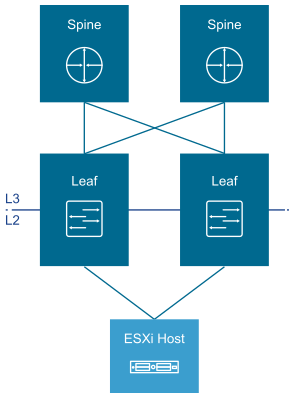You can implement the switch fabric at the physical layer by providing Layer 2 or Layer 3 transport services. For a scalable and vendor-neutral data solution, use a Layer 3 transport. Both layer 2 and layer 3 transport have benefits and drawbacks. When designing the network architecture, consider the following for Layer 2 and Layer 3 transport.
Layer 2 Transport Considerations
The following considerations apply to a design that uses Layer 2 transport:
-
Top-of-Rack (ToR) switches and upstream Layer 3 devices such as core switches and routers form a switched fabric.
-
The upstream Layer 3 devices terminate each VLAN and provide the default gateway functionality.
-
Uplinks from the ToR switch to the upstream Layer 3 devices are 802.1Q trunks carrying all required VLANs.

| Characteristic |
Description |
|---|---|
| Benefits |
|
| Drawbacks |
|
The following considerations apply to a design that uses Layer 3 transport:
-
Layer 2 connectivity is limited to the ToR switches.
-
The ToR switch terminates each VLAN and provides the default gateway functionality. That is, it has a Switch Virtual Interface (SVI) for each VLAN.
-
Uplinks from the ToR switch to the upstream layer are routed point-to-point links. You cannot use VLAN trunking on the uplinks.
-
A dynamic routing protocol such as external Border Gateway Protocol (eBGP) connects the ToR switches and upstream switches. Each ToR switch advertises the prefixes, typically one per VLAN or subnet. In turn, the ToR switch calculates equal-cost paths to the prefixes received from the upstream layer it peers with.

| Characteristic |
Description |
|---|---|
| Benefits |
|
| Drawbacks |
|
Infrastructure Networks
Each ESXi host has multiple VMkernel port groups that are configured as infrastructure networks. The infrastructure networks include:
-
ESXi management network to handle the ESXi host management traffic.
-
vMotion network to handle the VMware vSphere vMotion® traffic.
-
vSAN network to handle the vSAN shared-storage traffic.
-
NFS network (optional) dedicated to offline storage, such as NFS, and used for backups and restores for the workloads that need it.
Tenant Networks
Tenant networks interconnect the VMs of the VMware Telco Cloud platform. The tenant networks include:
-
Management network dedicated VLAN for management component communication. DHCP is required for installing Kubernetes management nodes. Configure DHCP service and IP pool for management VLAN network and enable internet access.
-
vCenter HA network dedicated VLAN for VMware vCenter Server® High Availability traffic